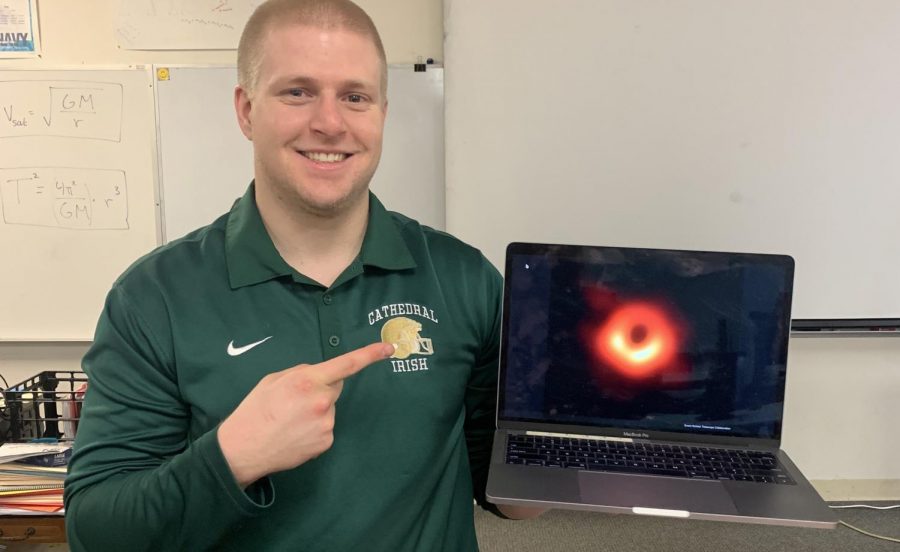Teacher explains significance of black hole photo
Image required eight telescopes, Hibshman says
In his classroom in the basement of Kelly Hall, astronomy and physics teacher Mr. Adam Hibshman shows off the image a black hole. He said he will explain to his classes the importance of the photo and the factors that led to scientists being able to capture the image.
Astronomers have announced the latest outer space discovery. They had finally captured an image of a black hole in the galaxy. Astronomy and physics teacher Mr. Adam Hibshman tells more about this photograph and provides his perspective on this historical event.
He said that he thinks this event is significant in a lot of ways, but not in the way the people would expect. “A couple of days before (the photo) came out, everybody, especially on the internet, was very excited that we were finally going to see a picture of a black hole.
“But knowing what I know about astronomy and physics, I knew that we weren’t going to be able to see whatever people thought that meant. What we were going to be able to see is what’s called the event horizon, or actually the accretion disk of the black hole,” Hibshman said.
He said that one of the factors that is significant about the photo is “the scientific endeavor that made this possible is kind of incredible.” What’s seen in the image is a ring with an orange glow around it, especially at the bottom because the force of the spinning black hole spins the debris around. The glow comes from debris from the galaxy falling into the black hole at about three-quarters the speed of light. That materials moves so fast that it actually catches fire and that’s what presents the orange glow.
“(The debris) is circling something called the event horizon. The event horizon is the point which if anything, including light, goes in, it can’t come out because gravity is too strong,” he said.
How the image came to be involved astronomers taking a picture of something very small from a very far distance and capturing an image for the first time of the matter falling into the black hole. He said that at the distance away of the black hole, it was like trying to take a picture of a golf ball on the moon.
“(Astronomers) had to get eight different telescope organizations to agree to all take pictures of this same object for a specific period of time. And then they took all those back in 2017, and there’s a young woman who wrote an algorithm that took all the data and was able to create this picture,” Hibshman said.
It takes a very long time to put all of the data together to create this image. He said that the computer science and ingenuity that went into taking all of the data and putting it together is incredible. “They asked all the eight different telescope organizations to work together, and instead of the telescope being the size of an individual telescope, when you have a network of them, the size of the telescope is basically the distance of the two farthest telescopes apart,” he said.
He added that scientists put together two telescopes on both sides of the planet, which means that the telescope is effectively the size of the earth.
What he will teach in his class is information on the black hole, the process of how astronomers were able to capture this picture, scientific discovery and techniques astronomers use.
“The other thing that’s cool about this is every year when new astronomy stuff happens in the world, I get to update my class. So next year for example, when we’re learning about how astronomers collect data and learn about the cosmos, this will be a great example,” he said.
He also will talk about how astronomers do their jobs. “They work together across the international scale, the process data, the do a lot of computer science, they try to confirm things like Einstein’s general theory of relativity,” Hibshman said.
Finally, Hibshman said that he thinks this particular discovery is also inspirational for both scientists and non-scientists because “the fact that we can get people from all over the world to agree inspires me a lot.”

Ava Amos is a senior and is the co-editor-in-chief of the Megaphone staff. She is a member of the varsity softball team and enjoys volunteering with the...







